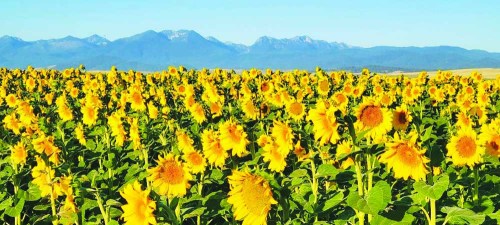Snowpack, damp spring douse the drought in Baker County
Published 8:25 am Friday, July 21, 2023

- Sunflowers blooming in a Baker Valley field with the Elkhorn Mountains in the background during the summer of 2022.
Mike Widman has endured multiple droughts during more than half a century running a cattle ranch in Baker County, and he relishes every sign that the latest dry spell has dissipated.
The lush green fescue on his 11,000 acres of rangeland in the Little Lookout Mountain country about 20 miles east of Baker City.
The typically placid desert streams frothing with snowmelt.
The hip-high grass in the hay meadows on his home ranch in Baker Valley, ready to be cut and baled in defiance of winter’s deprivations.
And of course the cattle, turning that summer grass into protein.
Widman has seen all that evidence during the spring and early summer of 2023, and he’s excited.
“We’re in good shape,” he said on June 27. “This is what I call a normal type of spring. The cattle are in great shape. It could be a banner year for grazing.”
Widman would have used none of these descriptions the previous few years.
Just that one word — drought — would have sufficed.
“The past couple years have been tough,” said Widman, whose family came to Baker County in 1864, just two years after the Oregon Legislature lopped off a chunk of Wasco County to create the new county.
“It’s a cycle.”
Widman is optimistic that the dry cycle is not merely waning but is being replaced by one that benefits ranchers and farmers across Northeastern Oregon.
This is the first year since 2019 in which, at the start of summer, most of Baker County is not in a moderate , severe or extreme drought, according to the U.S. Drought Monitor.
As of July 4, 2023, almost half the county — 47%, mainly in the central and southern sections — was neither in a drought nor abnormally dry, the precursor to the four-level drought rating system (moderate, severe, extreme and exceptional).
About 18% of the county, in the northeast corner including the Pine Valley around Halfway, was in moderate drought, while 35% was rated as abnormally dry.
A year earlier, 4% of the county was in extreme drought, 26% was in severe drought and 53% was in moderate drought. The rest was abnormally dry.
The situation was even worse in 2021, when most of the county was in severe or extreme drought on the summer solstice.
Started with snowpack
The drought started to ease months before Widman admired the grass in his meadows and on his range ground.
Winter snow was abundant, especially in the mountains.
And although January and February were drier than usual at the Baker City Airport — precipitation was about half of average for the two months — spring was decidedly different.
It was the wettest March at the airport since 2011, with 1.17 inches of precipitation (the long-term average is 0.79).
April was slightly drier than average — 0.65, compared with an average of 0.80 — but May, which statistically is the county’s dampest month, fulfilled its reputation, with 1.7 inches at the airport (average is 1.43).
June was slightly below average, with 1.14 inches (1.25 inches is the average), but it was the wettest June at the airport since 2013.
“We’re still getting pretty good runoff for the end of June,” Widman said.
A few snowdrifts gleamed on the north slopes of Little Lookout and its taller neighbor to the southeast, Big Lookout, on the solstice.
That’s a result of spring temperatures that were, until the second week of May, much cooler than average.
March, for instance, had the second-lowest average temperature at the airport since World War II.
Widman said the cool start to spring kept grass growth sluggish despite the ample moisture.
But once the weather pattern shifted in May, bringing higher-than-average temperatures for most of the rest of the month and much of June as well, the vegetation responded to the fecund combination, Widman said.
“Once the soil temperature started rising, the grass just took off,” he said.
Frequent showers during June nourished the new grass — a dramatically different situation compared with the previous several years, when the month was drier, and often warmer, than average.
Unlike the previous two years, Baker County commissioners didn’t approve a drought declaration, which can make farmers and ranchers eligible for state and federal aid.
Widman said that despite the abundant forage on his rangeland, he won’t deviate from his traditional, moderate approach to managing his cattle. The key, he said, is to leave about half the grass, to protect the plants and ensure they will continue to produce in years to come.
“You have to have balance,” Widman said. “I take care of my range — spraying weeds, planting grass, building fences.”
Elsewhere
In southern Baker County the weather can be dramatically different — and typically drier — than the northern sections.
But this year Mark Bennett, who runs a cattle ranch near Unity, concurs with Widman’s assessment.
“We’re doing really well,” Bennett said on June 27.
Bennett said springs, some of which dried up during the past few years, are flowing again on his ranch, and West Camp Creek, which runs through the property, was still running high in late June.
A small grass field near his home, for instance, was still green on that day even though he has yet to irrigate the ground.
“To get almost to July without irrigating a field and not having it dry up is really remarkable,” Bennett said.
The difference is especially dramatic compared with the previous two years, when Bennett said he started irrigating in March due to paltry winter snowpacks and a dry start to spring.
Although he’s hopeful, Bennett said the drought could reassert itself if the summer is unusually hot, dry and windy.
He said the top layer of the soil is damp, but when he’s had occasion to dig deeper he’s found that the soil remains dusty.
Bennett said the torrential downpours that were common this spring have limited benefits. The heavy rain is confined to a relatively small area, for one thing. And for another, if the cloudburst falls on ground that has little or no vegetation cover, much of the water runs off rather than soaks into the soil, he said.
Longer duration rain storms tend to do more to replenish drought-desiccated soil, Bennett said.
In eastern Baker County, Shella DelCurto, who is a cattle rancher, said that although the cold early spring stunted grass growth, once temperatures began to rise in early May the brown slopes quickly turned green.
“The range actually looked really good,” DelCurto said on June 27.
She said her family’s cattle grazing areas east of Halfway, near North Pine Creek, had snow much later than usual this spring.
Will Price, a rangeland expert with the Oregon State University Extension Service office in Baker County, said the continuation of frequent rain from May into June was especially beneficial in unirrigated rangelands.
“June rains definitely help a lot, it keeps the grass growing longer and prevents the soil from drying out,” Price said.
Curtis Martin, a cattle rancher who lives near North Powder, said rangelands are in excellent shape, especially compared with the previous few years of drought.
“There’s a tremendous amount of forage in the sagebrush steppe,” Martin said. “Everything looks healthier this year.”
Martin, who also has grazing land in northern Malheur County, said he has seen water flowing in that arid region in places that have been dry for many years.
“The recharge of groundwater has been just phenomenal,” he said.
Reservoirs
Chris Heffernan, who farms near North Powder in southern Union County, said both Pilcher and Wolf Creek reservoirs are full, and widespread rain during the spring has helped crops get a good start.
“It’s been great so far,” Heffernan said.
In southern Baker County, Unity Reservoir remained full until about the solstice. Earlier in the spring the multiple forks of the Burnt River were so swollen with snowmelt that the reservoir filled in late April, forcing the Burnt River Irrigation District to start spilling so much water that the river topped its banks downstream for several days in early May.
Farmers said that’s generally beneficial, serving as flood irrigation for the hay fields in the Burnt River Valley.
On July 6, Unity Reservoir was still at 86% of its capacity. Shawn Klaus, who manages the Burnt River Irrigation District and oversees water releases from the reservoir, said in May that he expects irrigation water will be ample this summer.
Thief Valley Reservoir, which supplies irrigation water to the Keating Valley, remained full until the last week of June and was 90% of capacity on July 6.
The largest reservoir completely inside Baker County — Phillips, along the Powder River in Sumpter Valley about 17 miles southwest of Baker City — didn’t fill.
But it came closer than any year since 2017.
The reservoir, depleted to nearly empty by severe drought in 2021 and 2022, reached about 73% of capacity in mid June of June 23.
Although Phillips started to drop slowly in early July, as of July 6 the reservoir was still holding 51,000 acre-feet of water, which is 70% of capacity and the highest figure for that date since 2017.
Late frost affects potatoes, corn, wheat
After six weeks or so of warmer than average weather in May and June, summer arrived with record low temperatures on two straight mornings in the Baker Valley.
The temperature dipped into the high 20s on both June 20 and June 21, causing frost damage to potatoes, field corn and wheat.
Farmers were still assessing the extent of the damage in early July, but it appeared that the frost stunted some growth rather than killing any crops outright.
“This is what I call a normal type of spring. The cattle are in great shape. It could be a banner year for grazing.”
— Mike Widman, Baker County cattle rancher





